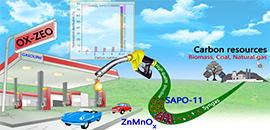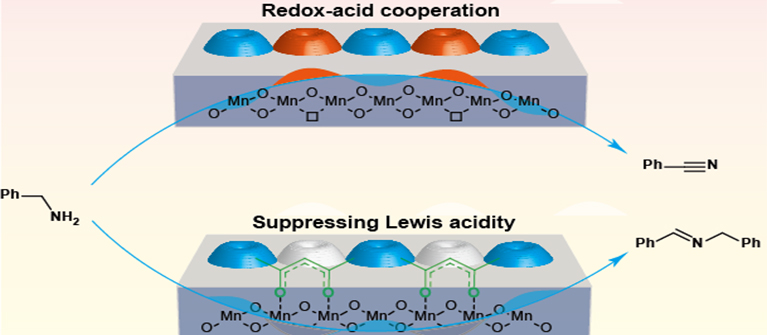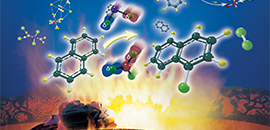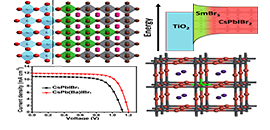Research News
-
 05 29, 2019DICP Scientists Achieve High-Quality Gasoline Directly from SyngasScientists achieved directly synthesis of high-quality gasoline from syngas.Recently, a research group led by Profs. PAN Xiulian and Prof. BAO Xinhe from the Dalian Institute of Chemical Physics (DICP) of the Chinese Academy of Sciences achieved directly synthesis of high-quality gasoline from syngas, their findings were published in Angewandte Chemie International Edition.Schematic of high-quality gasoline synthesis directly from syngas over OX-ZEO bifunctional catalysts. (Image by JIAO Feng)Syngas is an important intermediate platform for efficient utilization of carbon resources such as coal, natural gas and biomass, which can be converted to a variety of chemicals and fuels. However, precise control C-C coupling to fabricate desired products remains a challenge in syngas chemistry.The OX-ZEO (Oxide-Zeolite) catalyst design concept, which was reported by this research group, has enabled selective syngas conversion to mixed light olefins with a high selectivity of 80% among hydrocarbons, to ethylene with a selectivity of 83%, and to aromatics with a selectivity of 73.9% , far beyond the limits predicted by the ASF distribution model.“Here we reported one step transformation of syngas to gasoline with a selectivity of 77% at CO conversion of 20%. The hazardous aromatics content in gasoline (< 16%) was significantly lower than the limits set by most countries.” said Prof. PAN.“The ratio of isoparaffins to n-paraffins was as high as 15, giving a research octane number of 92 in contrast to about 35~43 obtained by the conventional low temperature Fischer-Tropsch synthesis.” PAN added.The aboved research provided a potential technology for one-step synthesis of high quality gasoline from a variety of carbon resources via syngas. It demonstrated again that the OX-ZEO catalyst concept was general and could be applicable for synthesis of other chemicals from syngas.This work was supported by the Ministry of Science and Technology of China, the Chinese Academy of Sciences and the National Natural Science Foundation of China. (Text by LI Na)
05 29, 2019DICP Scientists Achieve High-Quality Gasoline Directly from SyngasScientists achieved directly synthesis of high-quality gasoline from syngas.Recently, a research group led by Profs. PAN Xiulian and Prof. BAO Xinhe from the Dalian Institute of Chemical Physics (DICP) of the Chinese Academy of Sciences achieved directly synthesis of high-quality gasoline from syngas, their findings were published in Angewandte Chemie International Edition.Schematic of high-quality gasoline synthesis directly from syngas over OX-ZEO bifunctional catalysts. (Image by JIAO Feng)Syngas is an important intermediate platform for efficient utilization of carbon resources such as coal, natural gas and biomass, which can be converted to a variety of chemicals and fuels. However, precise control C-C coupling to fabricate desired products remains a challenge in syngas chemistry.The OX-ZEO (Oxide-Zeolite) catalyst design concept, which was reported by this research group, has enabled selective syngas conversion to mixed light olefins with a high selectivity of 80% among hydrocarbons, to ethylene with a selectivity of 83%, and to aromatics with a selectivity of 73.9% , far beyond the limits predicted by the ASF distribution model.“Here we reported one step transformation of syngas to gasoline with a selectivity of 77% at CO conversion of 20%. The hazardous aromatics content in gasoline (< 16%) was significantly lower than the limits set by most countries.” said Prof. PAN.“The ratio of isoparaffins to n-paraffins was as high as 15, giving a research octane number of 92 in contrast to about 35~43 obtained by the conventional low temperature Fischer-Tropsch synthesis.” PAN added.The aboved research provided a potential technology for one-step synthesis of high quality gasoline from a variety of carbon resources via syngas. It demonstrated again that the OX-ZEO catalyst concept was general and could be applicable for synthesis of other chemicals from syngas.This work was supported by the Ministry of Science and Technology of China, the Chinese Academy of Sciences and the National Natural Science Foundation of China. (Text by LI Na) -
 05 29, 2019Scientists Develop Surface Acidity- and Selectivity-Tunable Manganese Oxide CatalystScientists developed surface acidity- and selectivity-tunable manganese oxide catalyst using surface modification technique.
05 29, 2019Scientists Develop Surface Acidity- and Selectivity-Tunable Manganese Oxide CatalystScientists developed surface acidity- and selectivity-tunable manganese oxide catalyst using surface modification technique.
A research group led by Prof. XU Jie from the Dalian Institute of Chemical Physics (DICP) of the Chinese Academy of Sciences has developed a surface acidity- and selectivity-tunable manganese oxide catalyst using a surface modification technique. Their findings were published in Nature Communications.
Surface properties of transition metal oxides play a pivotal role in their catalytic applications. Despite numerous reports investigating the surface chemisorption of organic molecules on metal oxides, it is not clear how adsorption of organic modifiers can be exploited to optimize the catalytic properties of metal oxides.
Selectivity-tunable amines oxidation over acetylacetones-modified manganese oxide catalyst. (Image by JIA Xiuquan)
The researchers used enolic acetylacetones to modify the surface Lewis acid properties of manganese oxide catalysts. This enabled rational control of the oxidation selectivities of structurally diverse arylmethyl amines so they could switch from nitriles to imines.
The stable modification of acetylacetones strongly influenced the redox-acid cooperative catalysis of MnOx by suppressing the surface Lewis acidity of the catalysts. In the aerobic oxidation reaction of benzylamine, using unmodified MnOx as catalyst, nitrile was obtained with a yield of 86.5%. In contrast, the MnOx modified by acetylacetones produced imine with a yield of 90.6% under identical conditions.
The current study demonstrates an example of a selectivity-switchable metal oxide catalyst with an organic switch to tune its surface properties. This may contribute to future insights into the surface structure-activity relationships of metal oxide catalysts. (Text by JIA Xiuquan) -
 05 28, 2019Formation Mechanism of Highly Toxic Substances during Solid Waste Incineration RevealedScientists revealed the formation mechanism of highly toxic chlorinated aromatic compounds during solid waste incineration.
05 28, 2019Formation Mechanism of Highly Toxic Substances during Solid Waste Incineration RevealedScientists revealed the formation mechanism of highly toxic chlorinated aromatic compounds during solid waste incineration.
Recently, A group led by Prof. CHEN Jiping and Prof. ZHANG Haijun in the Dalian Institute of Chemical Physics (DICP) of the Chinese Academy of Sciences revealed the formation mechanism of highly toxic chlorinated aromatic compounds during solid waste incineration. Their findings were published in Environmental Science and Technology, and it was selected as the current Supplementary Cover.
A large number of aromatic compounds, such as benzene, phenol, biphenyl, polycyclic aromatic hydrocarbons and analogues, can be formed and emitted during solid waste incineration, accompanied by the formation and volatilization of chloride, chlorine and chlorine radicals.
In the incineration flue gas, these aromatic compounds can react with chlorine-containing species in a complex way to form chlorinated aromatic compounds, such as dioxins, polychlorinated biphenyls, polychlorinated naphthalene and chlorinated polycyclic aromatic hydrocarbons. These chlorinated compounds, which is known as their carcinogenic, teratogenic and mutagenic effects, have been partly listed as persistent organic pollutants by United Nations Environment Program. Therefore, their emission is specially monitored by environmental protection authorities.
Chlorination of aromatic hydrocarbons is a key step to control the formation of chlorinated aromatic compounds in incineration flue gas. Since too many substances and elementary reactions are involved, the formation mechanism of highly toxic chlorinated aromatic compounds during solid waste incineration has not been comprehensively and intensively understood, which limits the development of emission reduction technology of chlorinated aromatic compounds.
Dechlorination-oxychlorination cycles of Cu and Fe species drive naphthalene chlorination. (Image by WANG Dan and ZHANG Haijun)
The researchers investigated the effects of a series of metal oxides and chlorides, such as copper, iron, manganese, aluminum, chromium, nickel, etc., on the electrophilic chlorination of aromatics by simulating the reaction atmosphere of incineration flue gas and using naphthalene as a model compound.
“We found that copper and iron chlorides were the key active substances to promote the chlorination of naphthalene, and we revealed the mechanism of electrophilic chlorination of aromatic compounds driven by dechlorination–oxychlorination cycles of copper and iron species” said Prof. CHEN.
Copper chloride and ferric chloride could act as chlorinating agents to directly induce chlorination of aromatic compounds. In the dechlorination-oxychlorination cycle of copper species, the direct chlorination induced by copper chloride was the main mechanism of chlorination of aromatic compounds, while the direct chlorination and catalytic chlorination played the same role on the chlorination of aromatic compounds driven by dechlorination-oxychlorination cycle of iron species.
Based on the in-depth understanding of the chlorination mechanism of chlorinated aromatic compounds during solid waste incineration, the researchers developed a technology to inhibit the formation of chlorinated aromatic compounds such as dioxins from incineration sources, which has been applied in three large-scale municipal solid waste incineration power plants.
The above work was supported by DICP Innovation Fund the National Natural Science Foundation of China and the National Key Basic Research Development Plan (973). (Text by WANG Dan and ZHANG Haijun) -
 05 22, 20193D Graphene/Carbon Nanotube Aerogels for Ultrahigh Volumetric-Energy-Density Li-S Batteries DevelopedDICP scientists developed high volumetric-energy-density and long-life lithium sulfur (Li-S) batteries based on the free-standing, densely compact, and integrated cathode.
05 22, 20193D Graphene/Carbon Nanotube Aerogels for Ultrahigh Volumetric-Energy-Density Li-S Batteries DevelopedDICP scientists developed high volumetric-energy-density and long-life lithium sulfur (Li-S) batteries based on the free-standing, densely compact, and integrated cathode.
A research group led by WU ZhongShuai from the Dalian Institute of Chemical Physics (DICP) of the Chinese Academy of Sciences developed high volumetric-energy-density and long-life lithium sulfur (Li-S) batteries based on the free-standing, densely compact, and integrated cathode.
These Li-S batteries are derived from three-dimensional (3D) interconnected porous graphene/CNT aerogels, simultaneously serving as sulfur host and interlayer. Their findings were published in Nano Energy.
Lithium-sulfur (Li-S) batteries, as one highly competitive alternative for commercially available high-energy-density lithium metal batteries, have drawn considerable attentions on account of high theoretical gravimetric and volumetric energy density.
However, the practical applications of Li-S batteries have been hampered by several issues, including low mass densities of nano sulfur, intrinsically poor electrical conductivities of sulfur, large volume expansion of sulfur particle during cycling, and shuttling effect of lithium polysulfide, all of which result in low volumetric energy density and limited cyclability of Li-S batteries.
Hence, improving the gravimetric and volumetric energy density at the same time, as well as prolonging the cycle stability of the Li-S batteries, is the bottleneck of the applied research of the Li-S batteries.
Schematic of 3D graphene/carbon nanotube aerogels for ultrahigh volumetric-energy-density lithium-sulfur batteries. (Image by SHI Haodong and HOU Xiaocheng)
The scientists developed a free-standing, compact, conductive and integrated cathode, constructed by compressing graphene/carbon nanotubes aerogels, simultaneously serving as bi-functionalities of binder- and metal-current-collector-free sulfur host and interlayer for Li-S batteries.
The integrated cathode displayed high compaction density, outstanding mechanical flexibility and high electrical conductivity, which could endow the cathode with ultrahigh volumetric mass density, volumetric-energy-density, and exceptionally long-term cycling stability with an extremely low decay rate over 500 cycles at 2C.
This proposed integration cathode strategy would open numerous opportunities for constructing binder-free, current-collector-free, high-sulfur-loading and compact cathodes toward high-volumetric-energy-density and flexible Li-S batteries.
This work was supported by National Natural Science Foundation of China, National Key R&D Program of China, Dalian National Laboratory For Clean Energy (DNL), CAS, etc. (Text by SHI Haodong and HOU Xiaocheng) -
 05 21, 2019Scientists Develop New Lithium/Carbon Fluoride Battery with High Energy DensityDICP scientists developed a new lithium/carbon fluoride battery with high energy density.
05 21, 2019Scientists Develop New Lithium/Carbon Fluoride Battery with High Energy DensityDICP scientists developed a new lithium/carbon fluoride battery with high energy density.
Recently, a research team led by Prof. LI Xianfeng, Prof. ZHANG Huamin, and Prof. ZHANG Hongzhang from the Dalian Institute of Chemical Physics (DICP) of the Chinese Academy of Sciences developed a new lithium/carbon fluoride battery with high energy density.
The lithium/carbon fluoride battery was tested by a third-party authority, the institute of Chemical Power for Light Industry. It reported that the energy density of the advanced 10Ah energy-type lithium/carbon fluoride battery could reach to 940 Wh/kg (1150 Wh/L), which rewrote the energy density record of analogue batteries.
The lithium/carbon fluoride battery had an extremely low self-discharge rate, long shelf life (more than 10 years), no electrolyte corrosion hazard and low work temperature (-40 °C). Therefore it presented a superior performance than lithium/thionyl chloride batteries.
Moreover, the advanced power-type lithium/carbon fluoride battery could achieve the high energy density of 550 Wh/kg at a discharge rate of 1C, demonstrating that it had great potential application value in the electronic devices field. (Text by CHEN Yuqing) -
 05 21, 2019Scientists Improve Photovoltaic Performance of Inorganic Perovskite Solar CellsA research group led by Prof. LIU Shengzhong from the Dalian Institute of Chemical Physics (DICP) of the Chinese Academy of Sciences improved the photovoltaic performance of inorganic perovskite solar cells (PSCs).
05 21, 2019Scientists Improve Photovoltaic Performance of Inorganic Perovskite Solar CellsA research group led by Prof. LIU Shengzhong from the Dalian Institute of Chemical Physics (DICP) of the Chinese Academy of Sciences improved the photovoltaic performance of inorganic perovskite solar cells (PSCs).
A research group led by Prof. LIU Shengzhong from the Dalian Institute of Chemical Physics (DICP) of the Chinese Academy of Sciences improved the photovoltaic performance of inorganic perovskite solar cells (PSCs). Their findings were published in Advanced Energy Material and Nano Energy.
Schematic diagrams of SmBr3 modification at TiO2/CsPbIBr2 interface and Ba2+ doping in CsPbIBr2. (Image by WANG Kai and DUAN Lianjie)
Organic-inorganic metal halide perovskite solar cells have attracted extensive attentions due to their high power conversion efficiency (PCE). However, the perovskites usually exhibit poor stability due to the weak interaction between the organic cations and iodine-lead octahedrons, which restricts its further development for commercialization.
In contrast, all-inorganic perovskite materials (CsPbX3, X=I, Br) have become an emerging research subject due to their excellent thermal stability. However, due to the non-radiative recombination in PSCs based on inorganic perovskites, the photovoltaic performance still has a large room to improve.
In order to improve the PCE of inorganic PSCs, Prof. LIU adopted different strategies to suppress the non-radiative charge recombination in PSCs. In general, the non-radiative recombination in PSCs could be divided into two parts: interface recombination and non-radiative recombination in the perovskite layers.
For interface recombination, the researchers modified the electron transport layer/perovskite interface by using a lanthanide bromide and obtaining a gradient band structure at the interface, which inhibited the interface electron recombination successfully and enhanced the charge extraction as well. With this strategy, the PCE of CsPbIBr2-based PSCs was increased to 10.88%, representing a high level in this field.
In addition, barium ions were doped in CsPbIBr2 to suppress the inside non-radiative recombination. Although the radius of Ba2+ did not meet the requirements of the Goldschmidt rule, it could still optimize the optoelectronic properties of CsPbIBr2 and improved device stability.
This study showed that perovskite materials possessed a high tolerance to extrinsic metal ions.The above results provided a basis for the regulation strategy of inorganic perovskite and promoted the development of inorganic PSCs to a certain extent. (Text by WANG Kai and DUAN Lianjie)